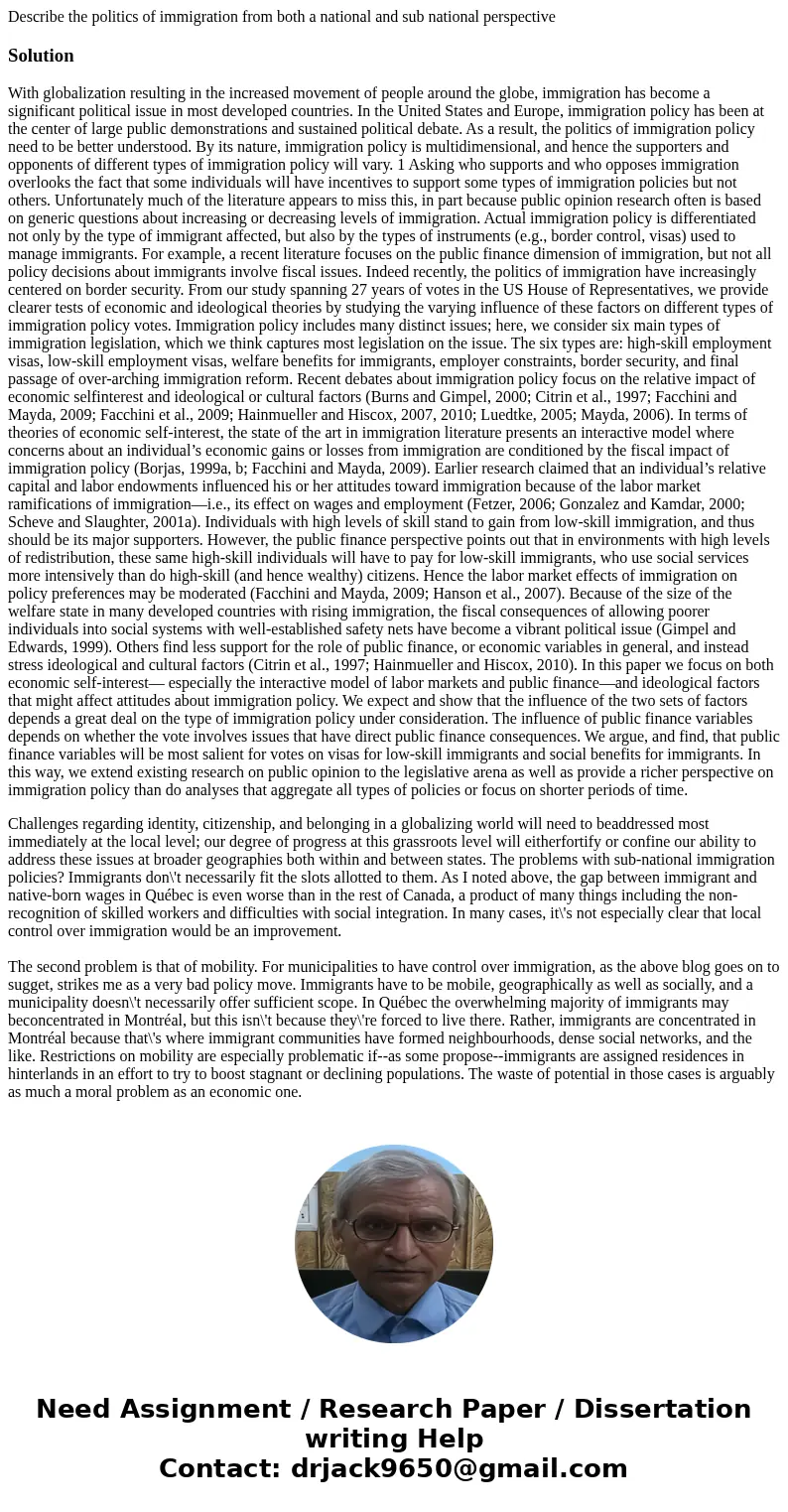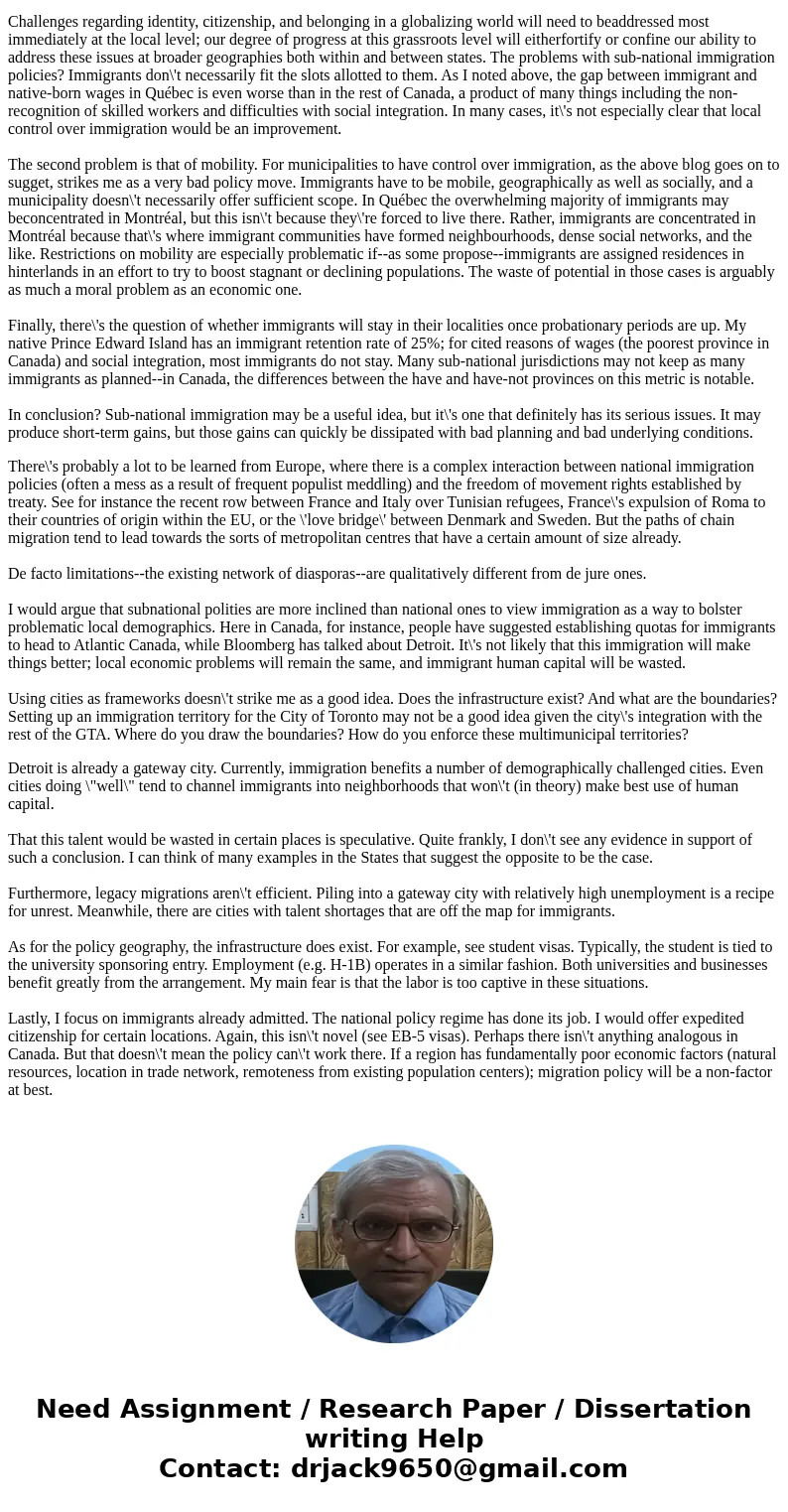Describe the politics of immigration from both a national an
Describe the politics of immigration from both a national and sub national perspective
Solution
With globalization resulting in the increased movement of people around the globe, immigration has become a significant political issue in most developed countries. In the United States and Europe, immigration policy has been at the center of large public demonstrations and sustained political debate. As a result, the politics of immigration policy need to be better understood. By its nature, immigration policy is multidimensional, and hence the supporters and opponents of different types of immigration policy will vary. 1 Asking who supports and who opposes immigration overlooks the fact that some individuals will have incentives to support some types of immigration policies but not others. Unfortunately much of the literature appears to miss this, in part because public opinion research often is based on generic questions about increasing or decreasing levels of immigration. Actual immigration policy is differentiated not only by the type of immigrant affected, but also by the types of instruments (e.g., border control, visas) used to manage immigrants. For example, a recent literature focuses on the public finance dimension of immigration, but not all policy decisions about immigrants involve fiscal issues. Indeed recently, the politics of immigration have increasingly centered on border security. From our study spanning 27 years of votes in the US House of Representatives, we provide clearer tests of economic and ideological theories by studying the varying influence of these factors on different types of immigration policy votes. Immigration policy includes many distinct issues; here, we consider six main types of immigration legislation, which we think captures most legislation on the issue. The six types are: high-skill employment visas, low-skill employment visas, welfare benefits for immigrants, employer constraints, border security, and final passage of over-arching immigration reform. Recent debates about immigration policy focus on the relative impact of economic selfinterest and ideological or cultural factors (Burns and Gimpel, 2000; Citrin et al., 1997; Facchini and Mayda, 2009; Facchini et al., 2009; Hainmueller and Hiscox, 2007, 2010; Luedtke, 2005; Mayda, 2006). In terms of theories of economic self-interest, the state of the art in immigration literature presents an interactive model where concerns about an individual’s economic gains or losses from immigration are conditioned by the fiscal impact of immigration policy (Borjas, 1999a, b; Facchini and Mayda, 2009). Earlier research claimed that an individual’s relative capital and labor endowments influenced his or her attitudes toward immigration because of the labor market ramifications of immigration—i.e., its effect on wages and employment (Fetzer, 2006; Gonzalez and Kamdar, 2000; Scheve and Slaughter, 2001a). Individuals with high levels of skill stand to gain from low-skill immigration, and thus should be its major supporters. However, the public finance perspective points out that in environments with high levels of redistribution, these same high-skill individuals will have to pay for low-skill immigrants, who use social services more intensively than do high-skill (and hence wealthy) citizens. Hence the labor market effects of immigration on policy preferences may be moderated (Facchini and Mayda, 2009; Hanson et al., 2007). Because of the size of the welfare state in many developed countries with rising immigration, the fiscal consequences of allowing poorer individuals into social systems with well-established safety nets have become a vibrant political issue (Gimpel and Edwards, 1999). Others find less support for the role of public finance, or economic variables in general, and instead stress ideological and cultural factors (Citrin et al., 1997; Hainmueller and Hiscox, 2010). In this paper we focus on both economic self-interest— especially the interactive model of labor markets and public finance—and ideological factors that might affect attitudes about immigration policy. We expect and show that the influence of the two sets of factors depends a great deal on the type of immigration policy under consideration. The influence of public finance variables depends on whether the vote involves issues that have direct public finance consequences. We argue, and find, that public finance variables will be most salient for votes on visas for low-skill immigrants and social benefits for immigrants. In this way, we extend existing research on public opinion to the legislative arena as well as provide a richer perspective on immigration policy than do analyses that aggregate all types of policies or focus on shorter periods of time.
Challenges regarding identity, citizenship, and belonging in a globalizing world will need to beaddressed most immediately at the local level; our degree of progress at this grassroots level will eitherfortify or confine our ability to address these issues at broader geographies both within and between states. The problems with sub-national immigration policies? Immigrants don\'t necessarily fit the slots allotted to them. As I noted above, the gap between immigrant and native-born wages in Québec is even worse than in the rest of Canada, a product of many things including the non-recognition of skilled workers and difficulties with social integration. In many cases, it\'s not especially clear that local control over immigration would be an improvement.
The second problem is that of mobility. For municipalities to have control over immigration, as the above blog goes on to sugget, strikes me as a very bad policy move. Immigrants have to be mobile, geographically as well as socially, and a municipality doesn\'t necessarily offer sufficient scope. In Québec the overwhelming majority of immigrants may beconcentrated in Montréal, but this isn\'t because they\'re forced to live there. Rather, immigrants are concentrated in Montréal because that\'s where immigrant communities have formed neighbourhoods, dense social networks, and the like. Restrictions on mobility are especially problematic if--as some propose--immigrants are assigned residences in hinterlands in an effort to try to boost stagnant or declining populations. The waste of potential in those cases is arguably as much a moral problem as an economic one.
Finally, there\'s the question of whether immigrants will stay in their localities once probationary periods are up. My native Prince Edward Island has an immigrant retention rate of 25%; for cited reasons of wages (the poorest province in Canada) and social integration, most immigrants do not stay. Many sub-national jurisdictions may not keep as many immigrants as planned--in Canada, the differences between the have and have-not provinces on this metric is notable.
In conclusion? Sub-national immigration may be a useful idea, but it\'s one that definitely has its serious issues. It may produce short-term gains, but those gains can quickly be dissipated with bad planning and bad underlying conditions.
There\'s probably a lot to be learned from Europe, where there is a complex interaction between national immigration policies (often a mess as a result of frequent populist meddling) and the freedom of movement rights established by treaty. See for instance the recent row between France and Italy over Tunisian refugees, France\'s expulsion of Roma to their countries of origin within the EU, or the \'love bridge\' between Denmark and Sweden. But the paths of chain migration tend to lead towards the sorts of metropolitan centres that have a certain amount of size already.
De facto limitations--the existing network of diasporas--are qualitatively different from de jure ones.
I would argue that subnational polities are more inclined than national ones to view immigration as a way to bolster problematic local demographics. Here in Canada, for instance, people have suggested establishing quotas for immigrants to head to Atlantic Canada, while Bloomberg has talked about Detroit. It\'s not likely that this immigration will make things better; local economic problems will remain the same, and immigrant human capital will be wasted.
Using cities as frameworks doesn\'t strike me as a good idea. Does the infrastructure exist? And what are the boundaries? Setting up an immigration territory for the City of Toronto may not be a good idea given the city\'s integration with the rest of the GTA. Where do you draw the boundaries? How do you enforce these multimunicipal territories?
Detroit is already a gateway city. Currently, immigration benefits a number of demographically challenged cities. Even cities doing \"well\" tend to channel immigrants into neighborhoods that won\'t (in theory) make best use of human capital.
That this talent would be wasted in certain places is speculative. Quite frankly, I don\'t see any evidence in support of such a conclusion. I can think of many examples in the States that suggest the opposite to be the case.
Furthermore, legacy migrations aren\'t efficient. Piling into a gateway city with relatively high unemployment is a recipe for unrest. Meanwhile, there are cities with talent shortages that are off the map for immigrants.
As for the policy geography, the infrastructure does exist. For example, see student visas. Typically, the student is tied to the university sponsoring entry. Employment (e.g. H-1B) operates in a similar fashion. Both universities and businesses benefit greatly from the arrangement. My main fear is that the labor is too captive in these situations.
Lastly, I focus on immigrants already admitted. The national policy regime has done its job. I would offer expedited citizenship for certain locations. Again, this isn\'t novel (see EB-5 visas). Perhaps there isn\'t anything analogous in Canada. But that doesn\'t mean the policy can\'t work there. If a region has fundamentally poor economic factors (natural resources, location in trade network, remoteness from existing population centers); migration policy will be a non-factor at best.


 Homework Sourse
Homework Sourse